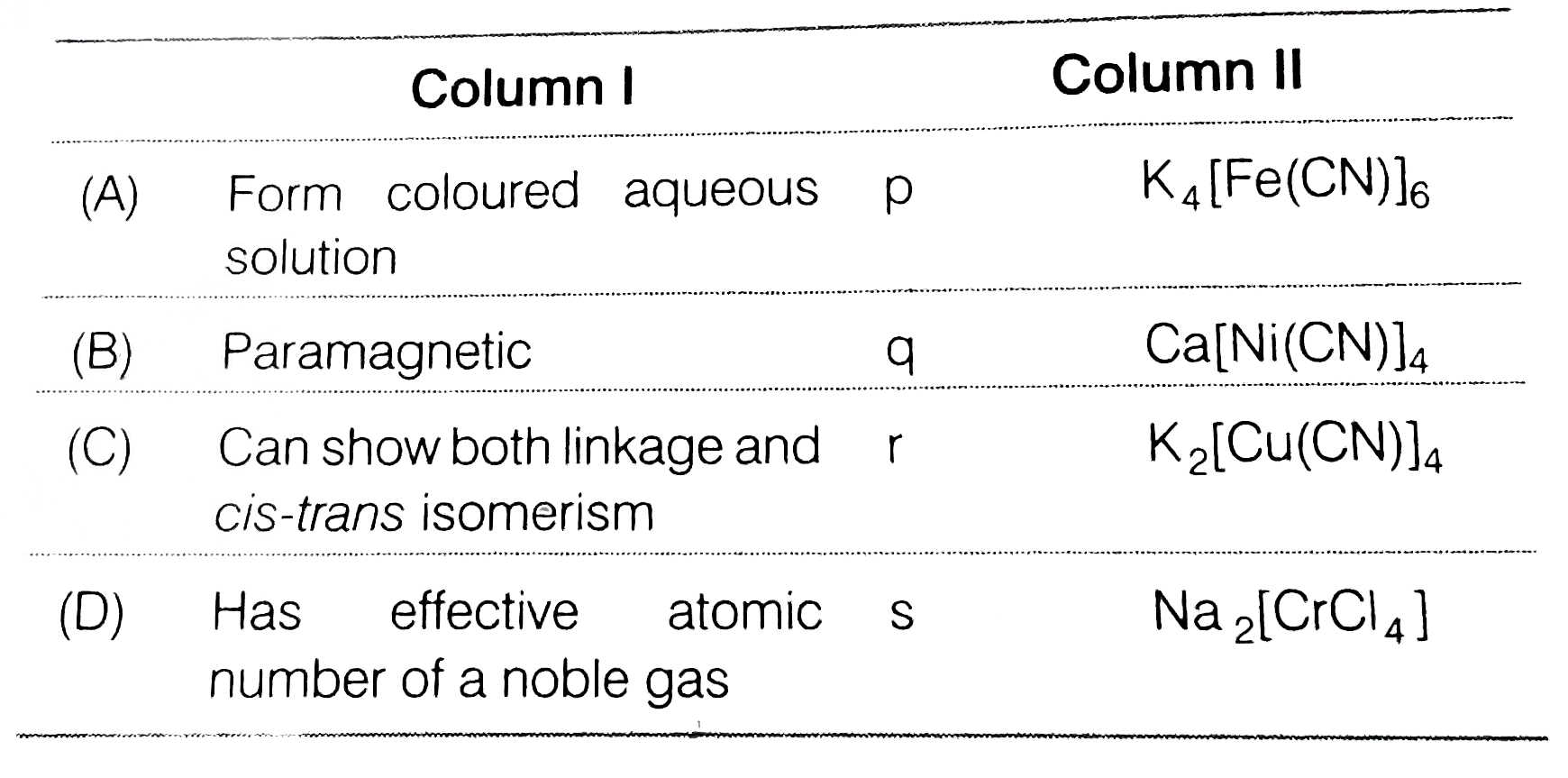Complete Solutions to PHYSICS of chapter COORDINATION COMPOUNDS of Class 12 book with complete answers and questions
| Class 12 | CHEMISTRY |
| Chapter | COORDINATION COMPOUNDS |
| IIT-JEE PREVIOUS YEAR | PHYSICS |
| Number Of Questions | 16 |
| Academic Year | 2023-24 |
Addition of excess aqueous ammonia to a pink coloured aqueous solution of `MCl_(2). 6H_(2)O (X)` and `NH_(4)Cl` gives an octahedral complex Y in the presence of air. In aqueous solution, complex Y behaves as `1 : 3` electrolyte. The reaction of X with excess `HCl` at room temperature results in the formation of a blue coloured complex Z. The calculated spin only magnetic moment of X and Z is `3.87 B.M.,` whersas it is zero for complex Y.
Among the following options, which statement (s) is (are) correct ?
View SolutionMatch the complexes in Column I with their properties listed in Column II

View SolutionA, B and C are three complexes of chromium (III) with the empirical formula `H_(2)O_(6)Cl_(3)Cr`. All the three complexes have water and chloride ion as ligands.
Complex A does not react with concentrated `H_(2)SO_(4)`, whereas complexes B and C lose `6.75 %` and `13.5 %` of their original mass, respectively, on treatment with concentrated `H_(2)SO_(4)`. Identify A, B and C
View SolutionWhich of the following are all features of isomers of `[Co (en)_(3)] Cl_(3)` ? Isomers are
View SolutionWhat is the relationship between the following two complex ions ?
(I) `[Co (NH_(3))_(4) Cl]^(+)`
(II) `[Co (NH_(3))_(4) (ONO) Cl]^(+)`
The complex ions are
View SolutionWhich of the following complexes have doubtful existence ?
View SolutionThe paramagnetic complexes is (are)
View SolutionComplexes expected to be coloured in solution is/are
View SolutionIn case of octahedral compex, if the `e_(g)` orbitals `(d_(x^(2) - y^(2)) " and " d_(z^(2)))` are asymmetricaaly filled, their degeneracy is destroyed and the ligands approaching along `+Z` and `-Z` directions experiences different amount of repulsions than the ligands approaching along the `+X, -X, +Y " and " -Y` directions. As a result, the symmetrical nature of such complexes is lost and either elongation or compression along Z-axis taken place. Answer the following three questions based on the above situation.
In which of the following case, no such elongation or compressions are expected ?
View SolutionIn case of octahedral compex, if the `e_(g)` orbitals `(d_(x^(2) - y^(2)) " and " d_(z^(2)))` are asymmetricaaly filled, their degeneracy is destroyed and the ligands approaching along `+Z` and `-Z` directions experiences different amount of repulsions than the ligands approaching along the `+X, -X, +Y " and " -Y` directions. As a result, the symmetrical nature of such complexes is lost and either elongation or compression along Z-axis taken place. Answer the following three questions based on the above situation.
Which of the following is incorrect regarding `K_(4) [Cr F_(6)]` ?
View SolutionIn case of octahedral compex, if the `e_(g)` orbitals `(d_(x^(2) - y^(2)) " and " d_(z^(2)))` are asymmetricaaly filled, their degeneracy is destroyed and the ligands approaching along `+Z` and `-Z` directions experiences different amount of repulsions than the ligands approaching along the `+X, -X, +Y " and " -Y` directions. As a result, the symmetrical nature of such complexes is lost and either elongation or compression along Z-axis taken place. Answer the following three questions based on the above situation.
Select the coorect statement.
View SolutionAssertion `[Ti (H_(2)O)_(6)] Cl_(4)` is colourless while `[Sc (H_(2)O)_(6)] Cl_(3)` is coloured.
Reason `d-d` transition is not possible in `[Ti (H_(2)O)_(6)] Cl_(4)`
View SolutionAssertion `[Ni (CO)_(4)]` has longer `C-O` bond length than the same in `[Cr(CO)_(5) NH_(3)]`
Reason There is greater extent of `d pi - rho pi` back bonding in `[Ni (CO)_(4)]` than in `[Cr (CO)_(5) NH_(3)]`
View SolutionMatch the quantity of Column I with the quantity of Column II

View SolutionHow many stereoisomers exist for the complex `[Co (en)_(2) ClNO_(2)] Br` ?
View SolutionThe complex `Ca_(2) [M (CN)]_(6)` has spin only magnetic moment `2.83 BM` and the complex `K_(2) [MCl_(4)]` has spin only magnetic moment of 4.9 BM. How many electrons were present in valence shell d-orbital of the neutral gaseous atom on M ?
View Solution
PHYSICS questions and complete solutions for chapter COORDINATION COMPOUNDS of IIT-JEE PREVIOUS YEAR (CHEMISTRY) of Class 12